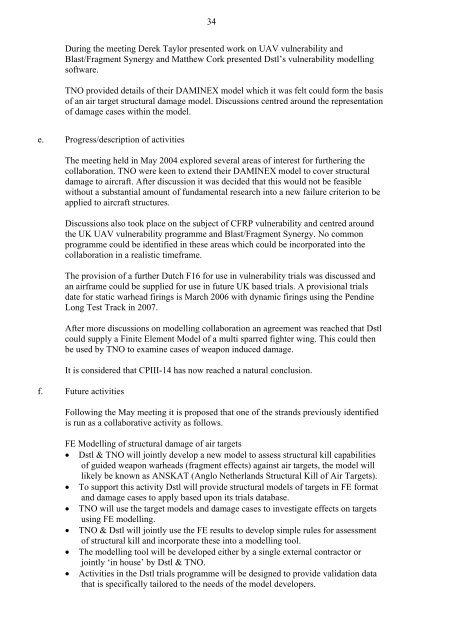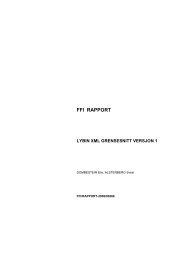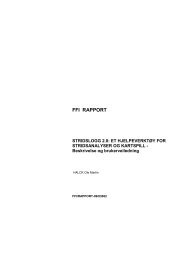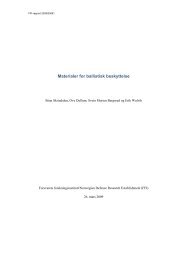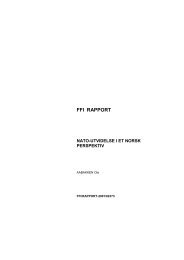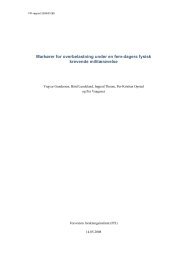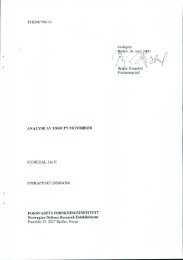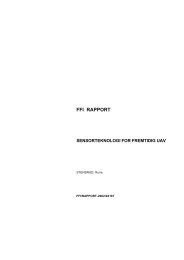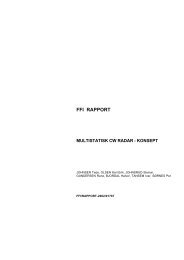Test 2 - FFI rapporter - Forsvarets forskningsinstitutt
Test 2 - FFI rapporter - Forsvarets forskningsinstitutt
Test 2 - FFI rapporter - Forsvarets forskningsinstitutt
You also want an ePaper? Increase the reach of your titles
YUMPU automatically turns print PDFs into web optimized ePapers that Google loves.
34<br />
During the meeting Derek Taylor presented work on UAV vulnerability and<br />
Blast/Fragment Synergy and Matthew Cork presented Dstl’s vulnerability modelling<br />
software.<br />
TNO provided details of their DAMINEX model which it was felt could form the basis<br />
of an air target structural damage model. Discussions centred around the representation<br />
of damage cases within the model.<br />
e. Progress/description of activities<br />
The meeting held in May 2004 explored several areas of interest for furthering the<br />
collaboration. TNO were keen to extend their DAMINEX model to cover structural<br />
damage to aircraft. After discussion it was decided that this would not be feasible<br />
without a substantial amount of fundamental research into a new failure criterion to be<br />
applied to aircraft structures.<br />
Discussions also took place on the subject of CFRP vulnerability and centred around<br />
the UK UAV vulnerability programme and Blast/Fragment Synergy. No common<br />
programme could be identified in these areas which could be incorporated into the<br />
collaboration in a realistic timeframe.<br />
The provision of a further Dutch F16 for use in vulnerability trials was discussed and<br />
an airframe could be supplied for use in future UK based trials. A provisional trials<br />
date for static warhead firings is March 2006 with dynamic firings using the Pendine<br />
Long <strong>Test</strong> Track in 2007.<br />
After more discussions on modelling collaboration an agreement was reached that Dstl<br />
could supply a Finite Element Model of a multi sparred fighter wing. This could then<br />
be used by TNO to examine cases of weapon induced damage.<br />
It is considered that CPIII-14 has now reached a natural conclusion.<br />
f. Future activities<br />
Following the May meeting it is proposed that one of the strands previously identified<br />
is run as a collaborative activity as follows.<br />
FE Modelling of structural damage of air targets<br />
• Dstl & TNO will jointly develop a new model to assess structural kill capabilities<br />
of guided weapon warheads (fragment effects) against air targets, the model will<br />
likely be known as ANSKAT (Anglo Netherlands Structural Kill of Air Targets).<br />
• To support this activity Dstl will provide structural models of targets in FE format<br />
and damage cases to apply based upon its trials database.<br />
• TNO will use the target models and damage cases to investigate effects on targets<br />
using FE modelling.<br />
• TNO & Dstl will jointly use the FE results to develop simple rules for assessment<br />
of structural kill and incorporate these into a modelling tool.<br />
• The modelling tool will be developed either by a single external contractor or<br />
jointly ‘in house’ by Dstl & TNO.<br />
• Activities in the Dstl trials programme will be designed to provide validation data<br />
that is specifically tailored to the needs of the model developers.


